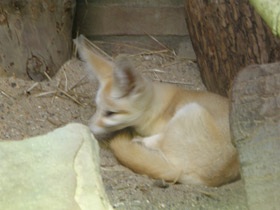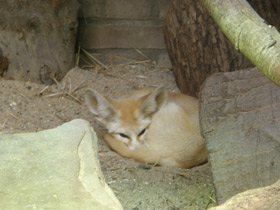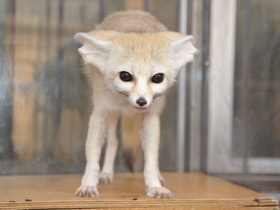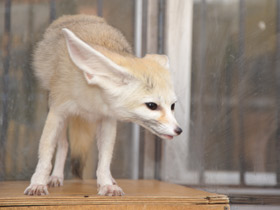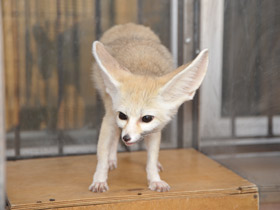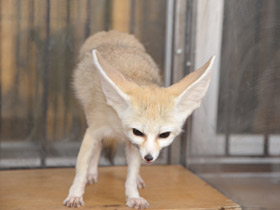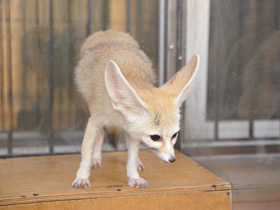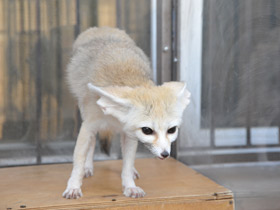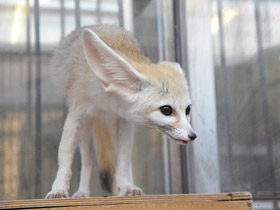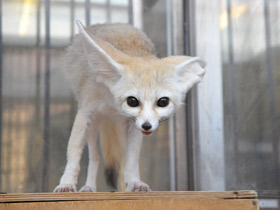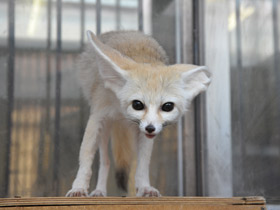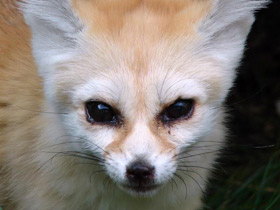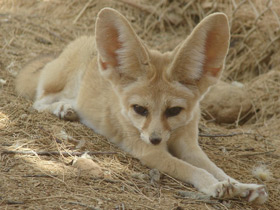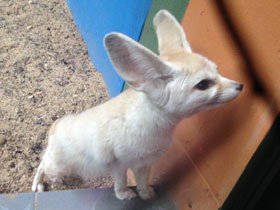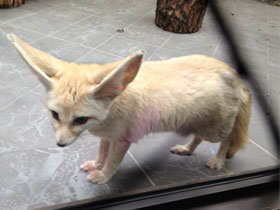The fennec fox (Vulpes zerda)
Fennec fox видео
The fennec fox (Vulpes zerda) is a small crepuscular fox native to the deserts of North Africa, ranging from Western Sahara and Mauritania to the Sinai Peninsula. Its most distinctive feature is its unusually large ears, which serve to dissipate heat and listen for underground prey. The fennec is the smallest fox species. Its coat, ears, and kidney functions have adapted to the desert environment with high temperatures and little water. It mainly eats insects, small mammals and birds. The fennec has a life span of up to 14 years in captivity and about 10 years in the wild. Its main predators are the Verreaux's eagle-owl, jackals and other large mammals. Fennec families dig out burrows in the sand for habitation and protection, which can be as large as 120 m2 (1,300 sq ft) and adjoin the burrows of other families. Precise population figures are not known but are estimated from the frequency of sightings; these indicate that the fennec is currently not threatened by extinction. Knowledge of social interactions is limited to information gathered from captive animals. The fennec's fur is prized by the indigenous peoples of North Africa, and it is considered an exotic pet in some parts of the world.
Its name comes from the species' Arabic name: fanak (فَنَك).
Taxonomy
Although Skjöldebrand named the species as Vulpes minimus in 1777, it was Zimmermann who first described it in 1780 as Canis zerda. Since then the species has been named as Canis cerdo Gmelin, 1788, Viverra aurita Meyer, 1793, Fennecus arabicus Desmarest, 1804, Megalotis cerda Illiger, 1811, Fennecus brucei Desmarest, 1820, Canis fennecus Lesson, 1827, Vulpes denhamii Boitard, 1842, Vulpes zaarensis J. E. Gray, 1843, Canis saharensis Leuck. via Gray, 1843, Canis pygmeus Leuck. via Gray, 1843 and Vulpes zerda Corbet, 1978.
The name Fennecus zerda was used by authors such as Ellerman and Morrison-Scott in 1966, Nowak in 1991 or Tedford et al. in 1995. However, molecular biology studies carried out since 1997 on the species conclude that it must remain in the genus Vulpes, having split from Vulpes cana between 4 and 4.5 million years ago.
Anatomically, it lacks a musk gland and has 32 pairs of chromosomes, unlike other fox species, which have between 35 and 39 pairs.
Appearance
Vulpes zerda is a species of carnivorous mammal in the family Canidae.
The term fenec comes from the Arabic for fox, and the specific epithet, zerda, which comes from the Greek, refers to its dry habitat (xeros). Other authors propose the meaning of "cunning" for the Greek translation of zerda.
The Vulpes zerda is the smallest member of the dog family, smaller than a domestic cat: its height at withers is 18-22 cm, body length 30-40 cm, tail length 30 cm and weight up to 1.5 kg. Its name comes from the Arabic word fanak, meaning "fox". The muzzle of the Vulpes zerda is short and pointed, with large eyes. The ears of the Vulpes zerda are the largest of all predators in relation to the size of its head; they are up to 15 cm long and are necessary to keep the body cool during the heat of the day. The foot of this chanterelle is pubescent, allowing it to walk on hot sand. Its teeth (especially the tusks) are small, its coat is dense and soft, of a protective colour: reddish or pale on top and white underneath; the tail is fluffy, with a black tip. The so-called "viola" or supracola gland, characteristic of all foxes, is hidden in Vulpes zerda under a dark, stiff coat.
Habitat and lifestyle
The largest population of Vulpes zerda inhabits the central Sahara, although it can be found from northern Morocco to the Sinai and Arabian peninsulas, and as far south as Niger, Chad and Sudan.
Vulpes zerda inhabits sandy deserts, where it prefers to cling to grassy thickets and bushes that provide shelter and food. It lives in burrows with many secret passages, which it digs for itself; it has a nocturnal lifestyle.
Vulpes zerda is a social animal; it lives in family groups of up to 10 individuals. They consist of a pair, their immature young and possibly several older offspring. Sometimes several families live together in the same den. Vulpes zerda are very "talkative": they bark, whine, growl and howl.
Nutrition
Vulpes zerda is omnivorous and draws most of its food from sand and soil. It prefers to hunt alone, like all foxes, and feeds mainly on small vertebrates, eggs, insects (including locusts), carrion, plant roots and fruits. Its huge ears allow the Vulpes zerda to pick up the slightest rustle produced by its prey. This small animal can go without water for long periods, obtaining its liquid from meat, berries and leaves. If food is plentiful, it makes a reserve. The Vulpes zerda shows great agility and liveliness, with the ability to jump high and far, up to 0.7 m high.
Reproduction
Vulpes zerda breeds once a year. They mate in January or February, but females are only in heat for two days. These animals are monogamous, each pair has its own site. During the breeding season, the males become aggressive and actively mark her with urine. Pregnancy lasts 50-53 days; in March and April the female gives birth to 2-6 cubs in a den with a nesting chamber lined with grass, feathers and wool. The cubs weigh only 50 g at birth. The mother stays with them in the den until they are two weeks old, when they open their eyes. The male carries the food but does not enter the burrow, as the female is very aggressive at this time and drives him away from the young. At 5 weeks of age, the cubs leave the den for the first time and wander around, but at about 3 months of age they start to move away. At the same time, females stop suckling.
Sexual maturity in Vulpes zerda occurs at 6-9 months of age. Sometimes Vulpes zerda pups remain with their parents and help raise new young.
Diseases
Captive fennec foxes are susceptible to canine distemper virus, displaying fever, mucopurulent ocular discharge, diarrhea, severe emaciation, seizures, generalized ataxia, severe dehydration, brain congestion, gastric ulcers and death. Stress because of capture and long-distance transportation are thought to be the causes.
Predators
African horned owl species such as the Pharaoh eagle-owl prey on fennec fox pups. Anecdotal reports exist about caracals, jackals, and striped hyenas also preying on the fennec fox. But according to nomads, the fennec fox is fast and changes directions so well that even their Salukis are hardly ever able to capture it.
Threats
In North Africa, the fennec fox is commonly trapped for exhibition or sale to tourists. Expansion of permanent human settlements in southern Morocco caused its disappearance in these areas and restricted it to marginal areas.
Conservation
As of 2015, the fennec fox is classified as Least concern on the IUCN Red List. It is listed in CITES Appendix II and is protected in Morocco and Western Sahara, Algeria, Tunisia and Egypt, where it has been documented in several protected areas.
In captivity
The fennec fox is bred commercially as an exotic pet. Commercial breeders remove the pups from their mother to hand-raise them, as tame foxes are more valuable. A breeders' registry has been set up in the United States to avoid any problems associated with inbreeding.
In culture
The fennec fox is the national animal of Algeria. It also serves as the nickname for the Algeria national football team "Les Fennecs".

















